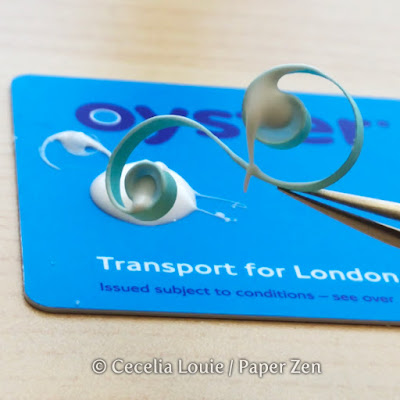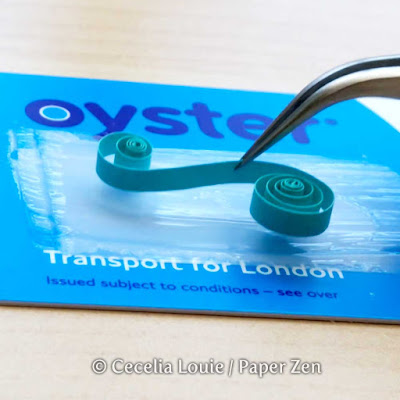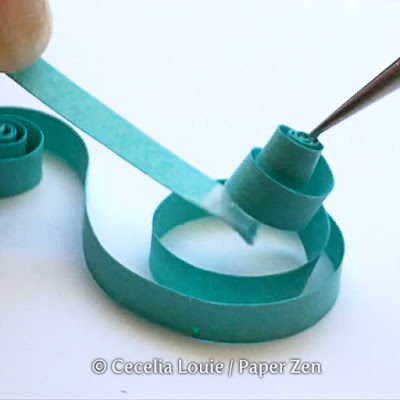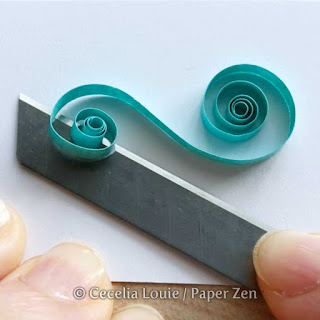Does your glue show on your quilling? I’m going to share all the gluing tips I’ve learned since I started in 2006.
Tip 1 – Smear Your Glue Puddle
I often see instruction to pour out some glue, and then to dip your quilling into the puddle, but it’s easy to overcoat your quilling strip this way, which means your glue will be seen on your final work surface.
Instead, I prefer to use another piece of plastic to smear the puddle flat. This way the depth of your glue puddle is very shallow.

This allows you to gently press the innermost coils into the glue, coating every bit of it.
When I pick it up, I pre-loosen the inner coils so the glue’s suction won’t destroy the smooth arcs.
After lifting, I always turn it upside down to check if I’ve missed coating any of it. If I did, I’ll simply re-dip again.
Tip 2 - Missed Spots
Now, if you coiled your strip unevenly, it’s quite easy to miss getting it dipped fully into the glue. Or maybe you missed dipped a certain section. What do you do if your strip is already on your work surface? Let me show you how to add glue in a case like this.
Apply glue to a scrap piece of quilling paper and slip it under the areas that are missing glue, the press your strip down.

Apply glue to a scrap piece of quilling paper and slip it under the areas that are missing glue, the press your strip down.

Tip 3 - Glue Dipping and Smearing Cards
When smearing my glue for dipping my pieces, I prefer to use a plastic card that has a matte surface rather than a high gloss surface. I usually use the Oyster card I got when I visited London.


Tip 4 - How to Undo Glued Pieces
As all quillers know, our work is hard to undo. If you’ve glued something down, don’t just tear it up. You’ll end up tearing the fibres of your work surface.
Instead, I extend an x-acto knife and slowly slice through the glue horizontally. This is another reason why it’s good to use as little glue as possible.
If you have some stubborn bits, you may need to scrape the surface a bit. I then use an eraser to gently scour the fragments. Finally I use a bone folder to smoothen the surface as much as possible.
I only remove my quilling as a last resort, and you’ll get the best results the faster you make your decision before the glue fully dries. I do suggest that you practice on a scrap piece first.

I hope these tips help you with your quilling. I love reading your comments and hearing which tip you found the most helpful, because then it helps me decide what to show you in the future. Or if you have any tips to share, please comment so we can all learn from you as well.
Instead, I extend an x-acto knife and slowly slice through the glue horizontally. This is another reason why it’s good to use as little glue as possible.
If you have some stubborn bits, you may need to scrape the surface a bit. I then use an eraser to gently scour the fragments. Finally I use a bone folder to smoothen the surface as much as possible.
I only remove my quilling as a last resort, and you’ll get the best results the faster you make your decision before the glue fully dries. I do suggest that you practice on a scrap piece first.

Tip 5 - My Favorite Quilling Glue Brand
I’m often asked what brand of glue I use. My favourite is Aleene’s Tacky Glue because it’s thick and dries fast. I use the large bottle when I need to smear it for dipping, and I put it in a fine tip bottle for applying directly onto my quilling strips. I store it upside down in a shot glass with a wet tissue at the bottom so it doesn’t clog and is always ready to use.I hope these tips help you with your quilling. I love reading your comments and hearing which tip you found the most helpful, because then it helps me decide what to show you in the future. Or if you have any tips to share, please comment so we can all learn from you as well.


